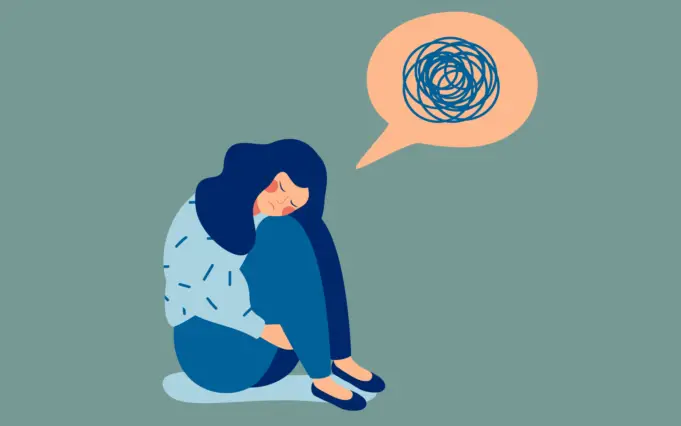Individuals who have GAD (generalized anxiety disorder), are known to worry uncontrollably about the most unnecessary things and situations. Sometimes, it is also called chronic anxiety neurosis.
A lot of people may mistake the common feelings of anxiousness for GAD, but they are two different things. It is quite common or normal to feel anxious about the things that happen in your daily life; such as you finances and relationships.
However, a person who suffers from GAD may worry or be anxious about the same thing several times in a single day, and even find it difficult to do anything else asides worry.
Such behaviors can occur even when there is absolutely no reason to be worried. Sometimes, individuals who suffer from GAD have no reason to experience anxiety, but they simply begin to worry.
People like this may also report a feeling that something bad is about to happen to them, or something negative may occur. They may also report an inability to calm themselves, no matter how hard they try.
Symptoms of GAD
There are a number of common symptoms associated with Generalized anxiety disorder:
- Irritability
- Difficulty sleeping
- Shaking
- Difficulty concentrating
- Exhaustion and fatigue
- Muscle tension
- Diarrhea or repeated stomach ache
- Rapid heartbeat
- Sweaty palms
- Some neurological symptoms like tingling in various parts of the body
How to distinguish GAD from other mental health conditions
One symptom that is most common amongst many mental health conditions is anxiety. People who suffer from mental health issues like phobias and depression also report experiencing anxiety. However, it is important to note that GAD is completely different from all these mental health conditions.
People who suffer from depression only experience anxiety occasionally, and those who have specific phobias know what exactly causes them to worry.
In the case of generalized anxiety disorder find themselves worrying about a wide range of things at the same time, and these things vary from time to time.
A person who has dealt with such unnecessary episodes of anxiety over 6 months or longer, or they find it difficult to identify the cause of their worry can be said to be dealing with GAD.
Causes and Risk factors of GAD
The causes and risk factors of generalized anxiety disorder may include the following:
- A recent or prolonged experience or exposure to disturbing situations, including family or personal illnesses
- A family history of anxiety
- Childhood abuse
- Excessive use of tobacco or caffeine, which can make already existing cases of anxiety worse
The Mayo clinic reports that women stand a greater chance of suffering from GAD than men.
Generalized anxiety disorder diagnosis
Generalized anxiety disorder is diagnosed only via a mental health screening that is performed by your primary care provider.
Your primary care provider will have to ask you a number of questions about the symptoms you experience, and how long you have dealt with them. You may be referred to a mental health specialist, like a psychiatrist or psychologist.
The doctor may also need to carry out carry out medical tests to find out whether you have an underlying medical condition or you are dealing with a substance abuse problem that is responsible for the symptoms you experience.
Anxiety has been traced to conditions such as:
- Heart disease
- Thyroid disorder
- Menopause
- Gasteroesophageal reflux disease
If there is any reason for your primary care provider to feel like substance abuse or a medical condition is responsible for the anxiety you suffer, there may be need for more tests to be carried out.
Such tests may include:
- Urine test
- Blood test
- Gastric reflux test
- X-rays and tress tests
Treatment for generalized anxiety disorder
There are a number of ways that GAD can be treated, and below are a number of them:
Cognitive behavioral therapy
The cognitive behavioral therapy treatment involved regular meetings to discuss with mental health professionals.
The main aim here is to change the way a person with GAD thinks or behaves. This is an approach that has been successful in the creation of permanent change in various individuals with anxiety.
CBT is considered a first-line method of treatment for treating pregnant women with anxiety disorder. Many who have been treated with this method record long term relief and control over their thoughts.
During a therapy session, you will learn the best way to recognized and control the thoughts that cause your anxiety. Your therapist will be there to teach you easy ways to calm yourself when you have upsetting thoughts.
You may have to use medications together with therapy for the treatment of GAD.
Medication for GAD
Sometimes, there may be need for your doctor to prescribe medications for your treatment. The doctor may most likely create a long-term or short-term medication plan for you.
The medications prescribed for short-term treatment are designed to prevent or control some of the physical symptoms such as stomach cramps and muscle tensions.
Below are some of the common anti-anxiety medications prescribed for short-term use:
- Clonazepam (Klonopin)
- Alprazolam (Xanax)
- Lorazepam (Ativan)
Anti-anxiety medications are not designed to be taken for prolonged periods of time because they are known to have a high risk of abuse and dependence.
Medications known as antidepressants function well for long-term treatment fo conditions like GAD. Below are some common antidepressants:
- Escitalopram (Lexapro)
- Fluoxetine (Prozac, Prozac Weekly, Sarafem)
- Buspirone (Buspar)
- Citalopram (Celexa)
- Fluvoxamine (Luvox, Luvox CR)
- Venlafaxine (Effexor XR)
- Desvenlafaxine (Pristiq)
- Paroxetine (Paxil, Paxil CR, Pexeva)
- Sertraline (Zoloft)
- Duloxetine (Cymbalta)
Medications like this may take a few weeks before they start working. Also, they can have side effects such as nausea, dry mouth, and diarrhea. The symptoms may bother some patients so much that the3y avoid these medications altogether.
Lifestyle changes for the treatment of generalized anxiety disorder
It is possible for many people with GAD to find relief by adopting some specific lifestyle habits.
These habits may include:
- Yoga and meditation
- A healthy diet. Regular exercise, and lots of sleep
- Staying away from stimulants like OTC meds, coffee, caffeine pills, and diet pills.
- People with GAD can get better with time and dedication to their treatments.
References:
- Generalized anxiety disorder (GAD). (2015, October) adaa.org/understanding-anxiety/generalized-anxiety-disorder-gad













